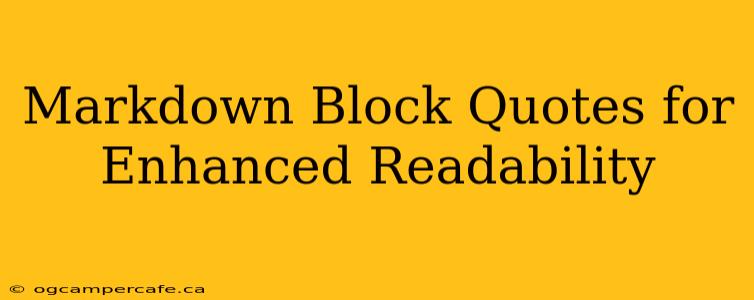Markdown, a lightweight markup language, offers a simple yet effective way to format text for readability. Among its many features, block quotes stand out as a powerful tool for highlighting important information, separating distinct voices, and improving the overall visual appeal of your document. This guide will delve into the nuances of using Markdown block quotes, explaining their purpose and showcasing best practices for optimal readability.
What are Markdown Block Quotes?
Markdown block quotes are used to set apart a section of text, visually distinguishing it from the surrounding content. They're particularly useful for:
- Quoting directly from another source: This ensures proper attribution and avoids plagiarism.
- Highlighting key takeaways or important insights: Block quotes draw the reader's eye to crucial information.
- Presenting different perspectives or opinions: They help to separate distinct voices within a single document.
- Improving the overall readability: Breaking up large chunks of text with block quotes makes the content more digestible and appealing.
How to Create a Markdown Block Quote
Creating a block quote in Markdown is straightforward. Simply prefix each line of the quoted text with a > symbol. For example:
> This is a block quote. It's set apart from the surrounding text,
> making it easy to read and visually distinct. You can have multiple
> lines within a single block quote.
This will render as:
This is a block quote. It's set apart from the surrounding text, making it easy to read and visually distinct. You can have multiple lines within a single block quote.
Nested Block Quotes
You can even nest block quotes within each other, creating a hierarchy of quotations. This is useful for quoting a quote, or for representing a conversation. To nest a quote, simply use additional > symbols:
> This is the main quote.
>> This is a nested quote, indented further to show it's within the main quote.
>>> This is another level of nested quote.
This will render as:
This is the main quote.
This is a nested quote, indented further to show it's within the main quote.
This is another level of nested quote.
Adding Attributes to Block Quotes
While Markdown's basic block quote functionality is quite powerful, you can enhance it further by adding attributes. While not a standard part of Markdown, many Markdown renderers support adding a citation or attribution at the end of the block quote using HTML. For example:
> This is a block quote with an attribution. <cite>- John Smith</cite>
This would typically render as:
This is a block quote with an attribution. - John Smith
Common Mistakes to Avoid
- Inconsistent spacing: Ensure consistent spacing before and after your block quotes.
- Forgetting the
>symbol: Each line within a block quote must begin with a>. - Overusing block quotes: While useful, overuse can make your document seem cluttered and less impactful. Use them judiciously to emphasize key points.
Best Practices for Readability
- Keep quotes concise: Long, rambling quotes can be difficult to read. Break them up if necessary.
- Use clear and concise language: The quote itself should be easy to understand.
- Provide context: Introduce the quote with a brief explanation to set the stage for the reader.
By mastering the art of Markdown block quotes, you can significantly improve the readability and impact of your written content. Remember to use them strategically to highlight key information and enhance the overall user experience. Following these best practices will help you create clear, well-structured, and engaging documents.
